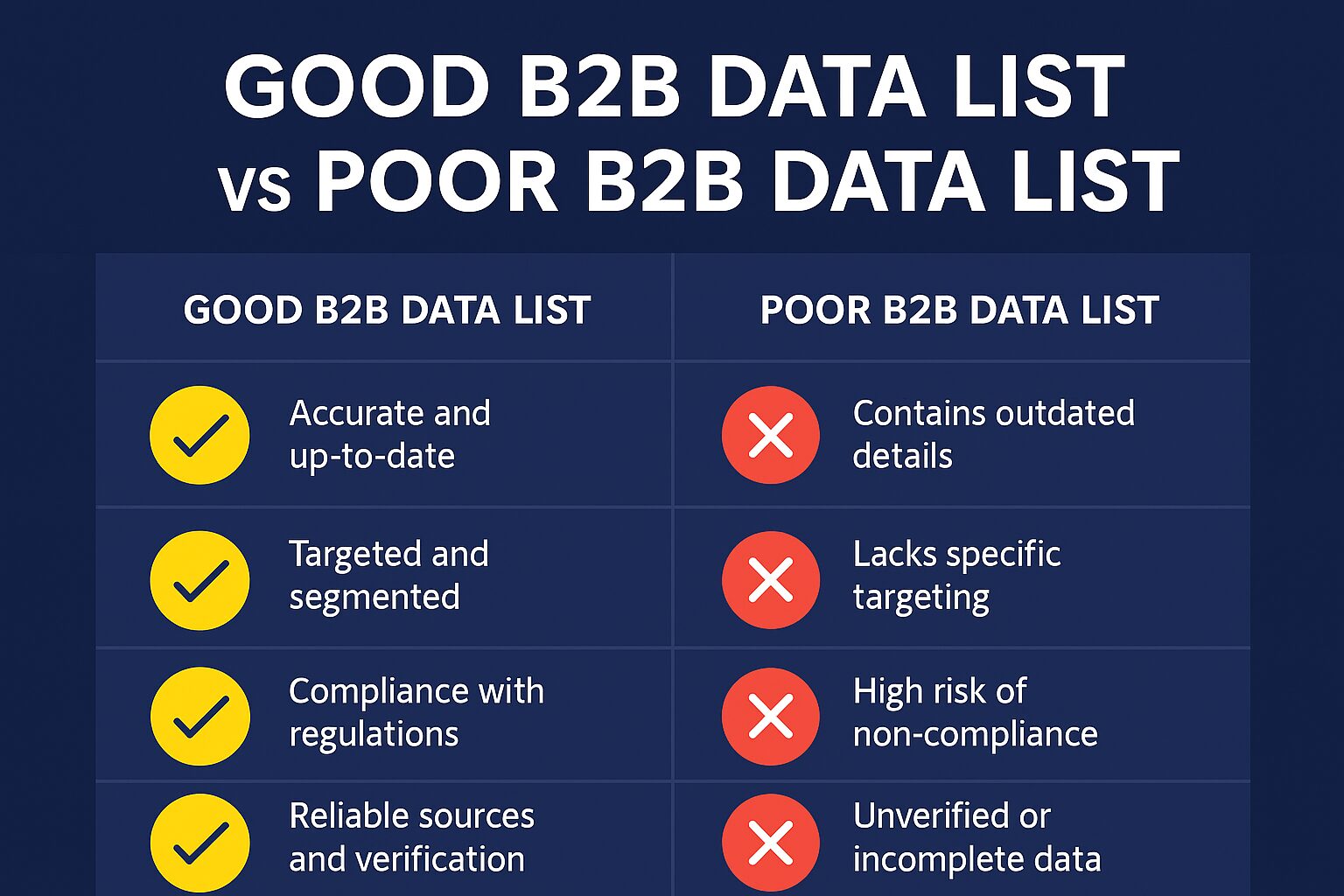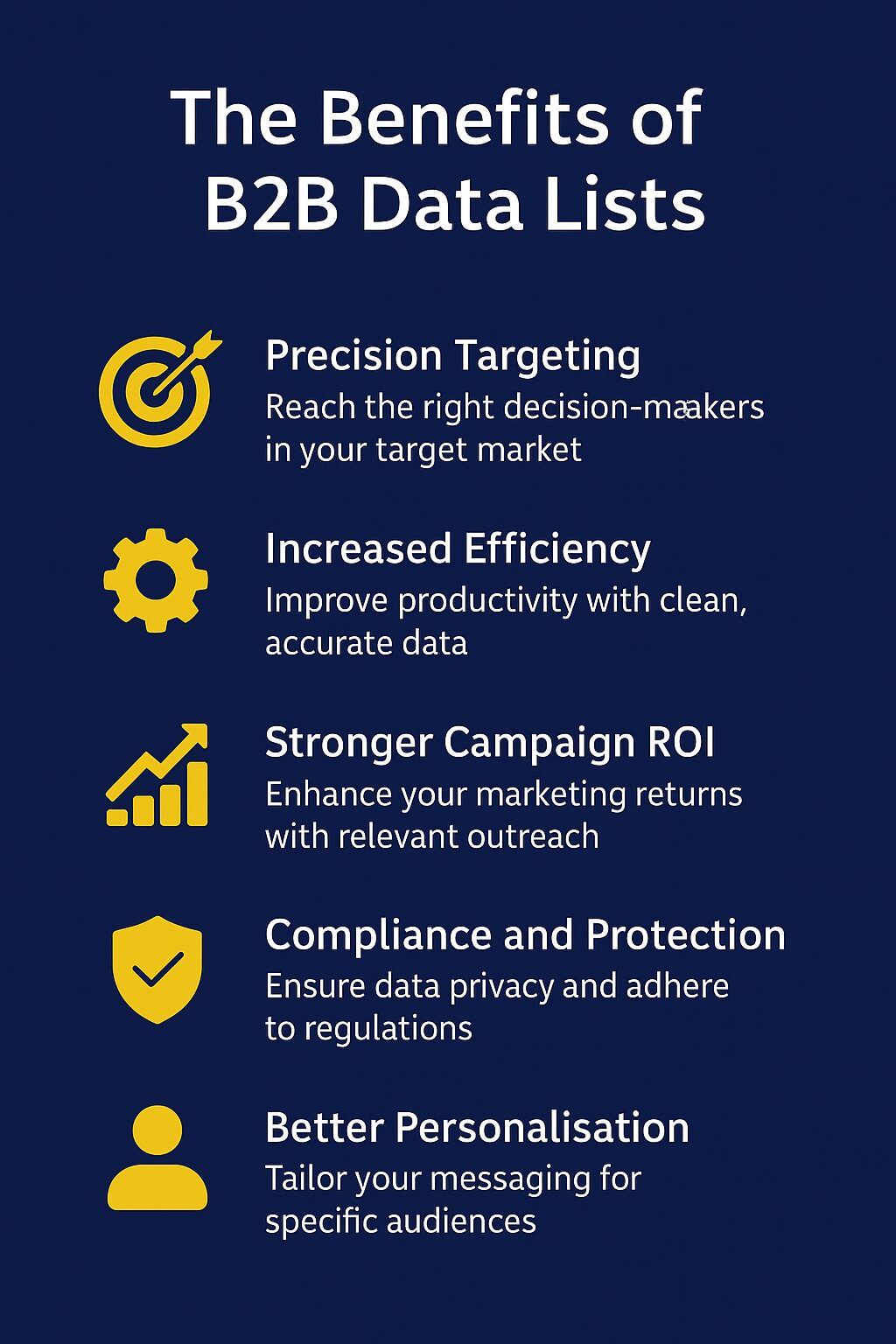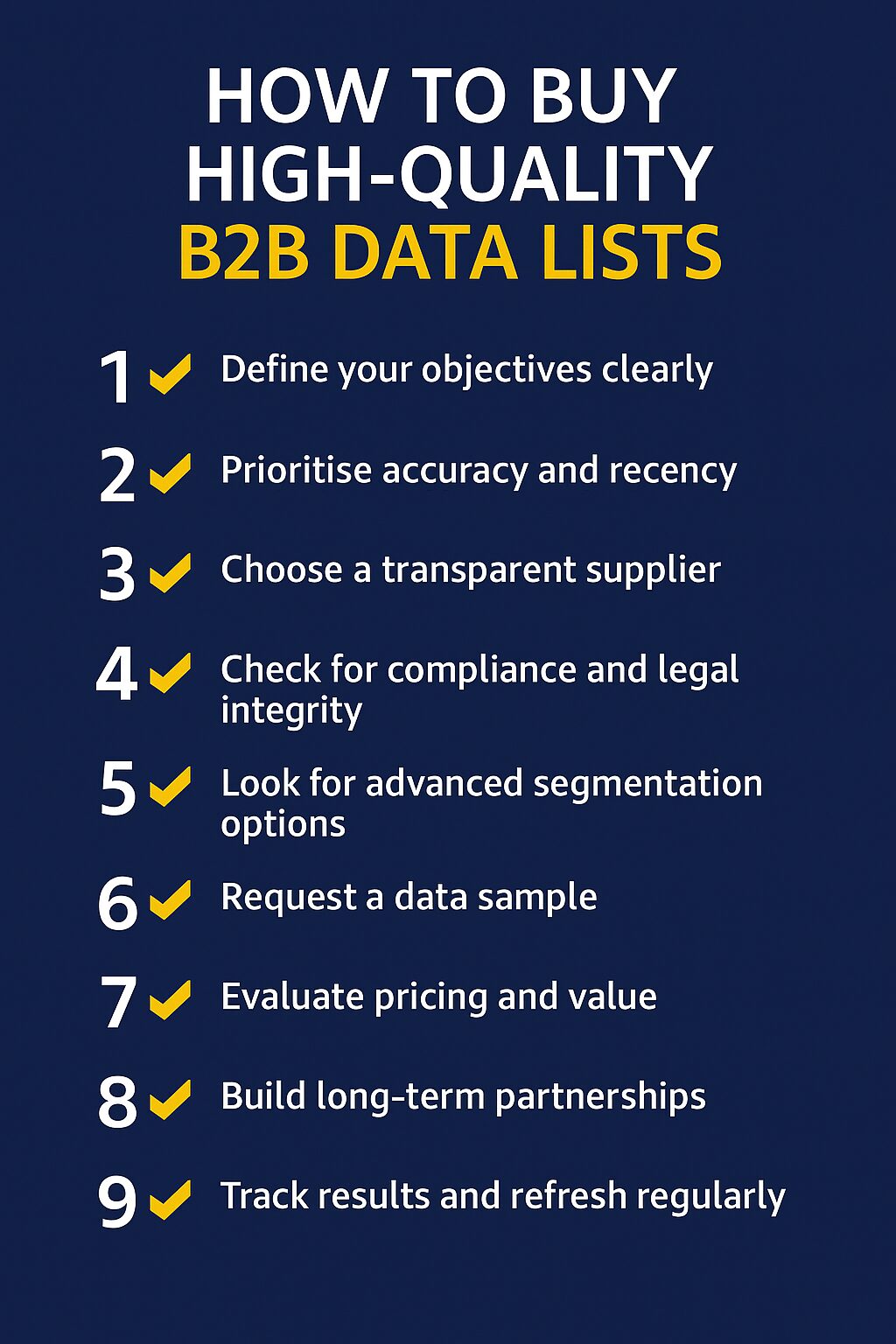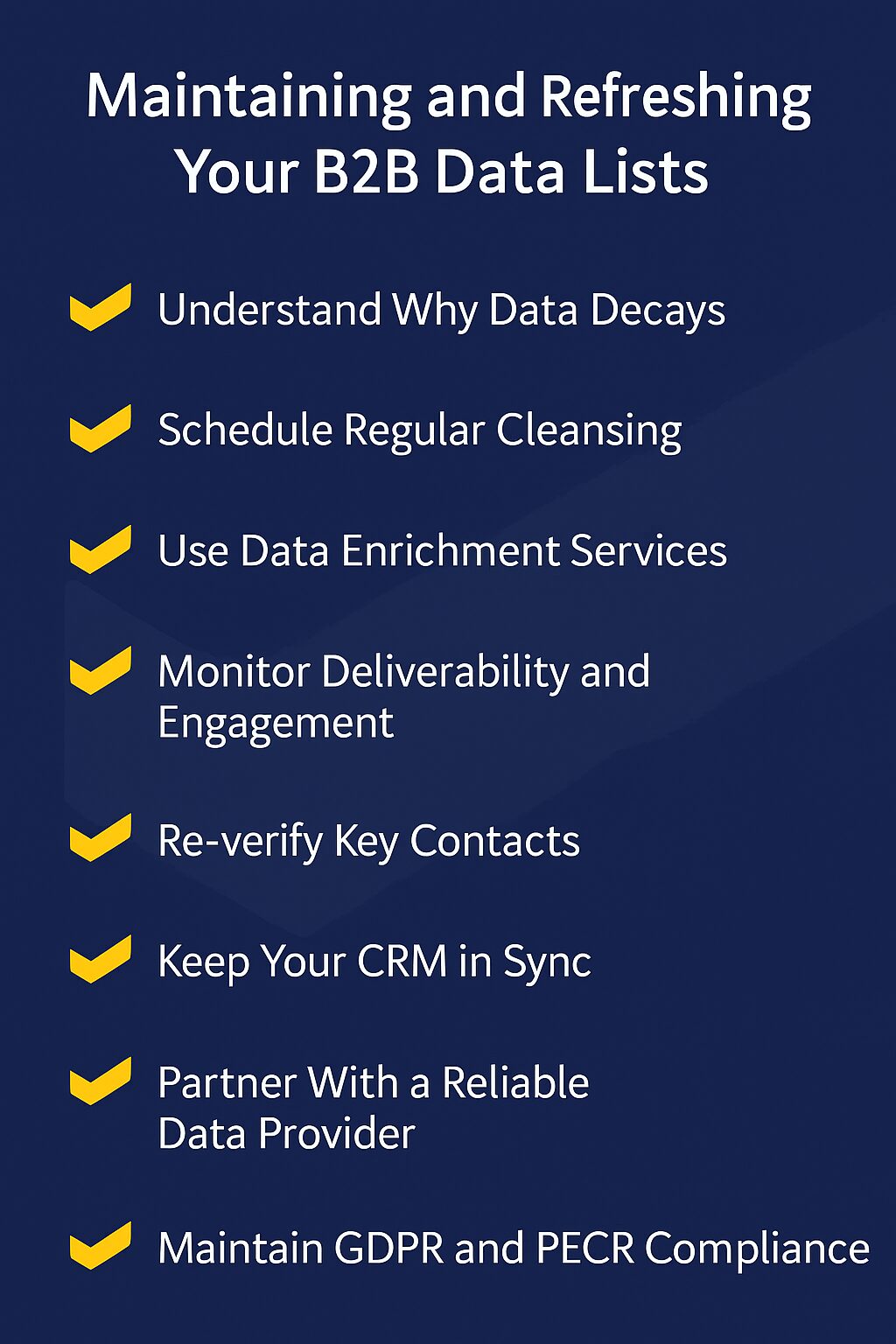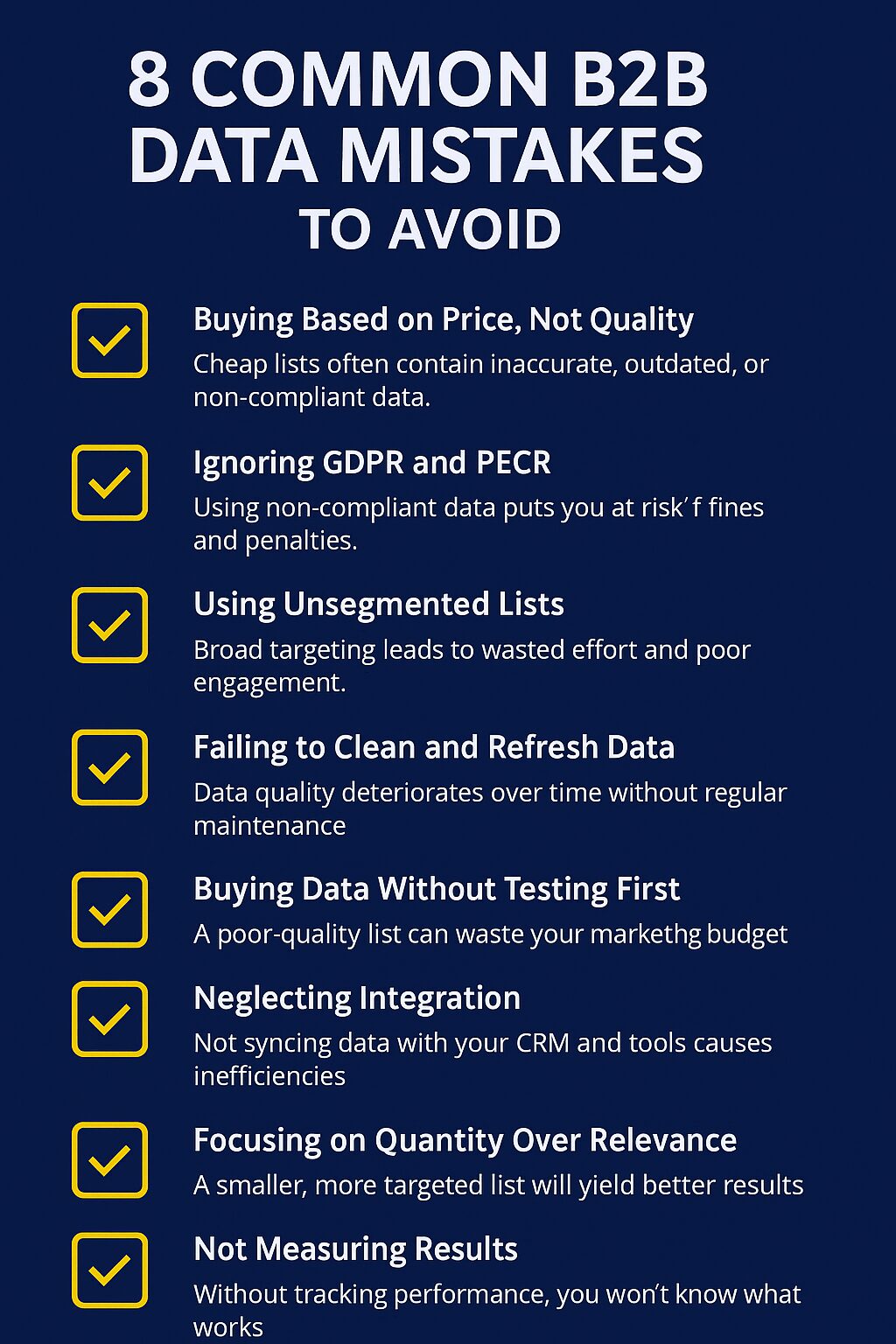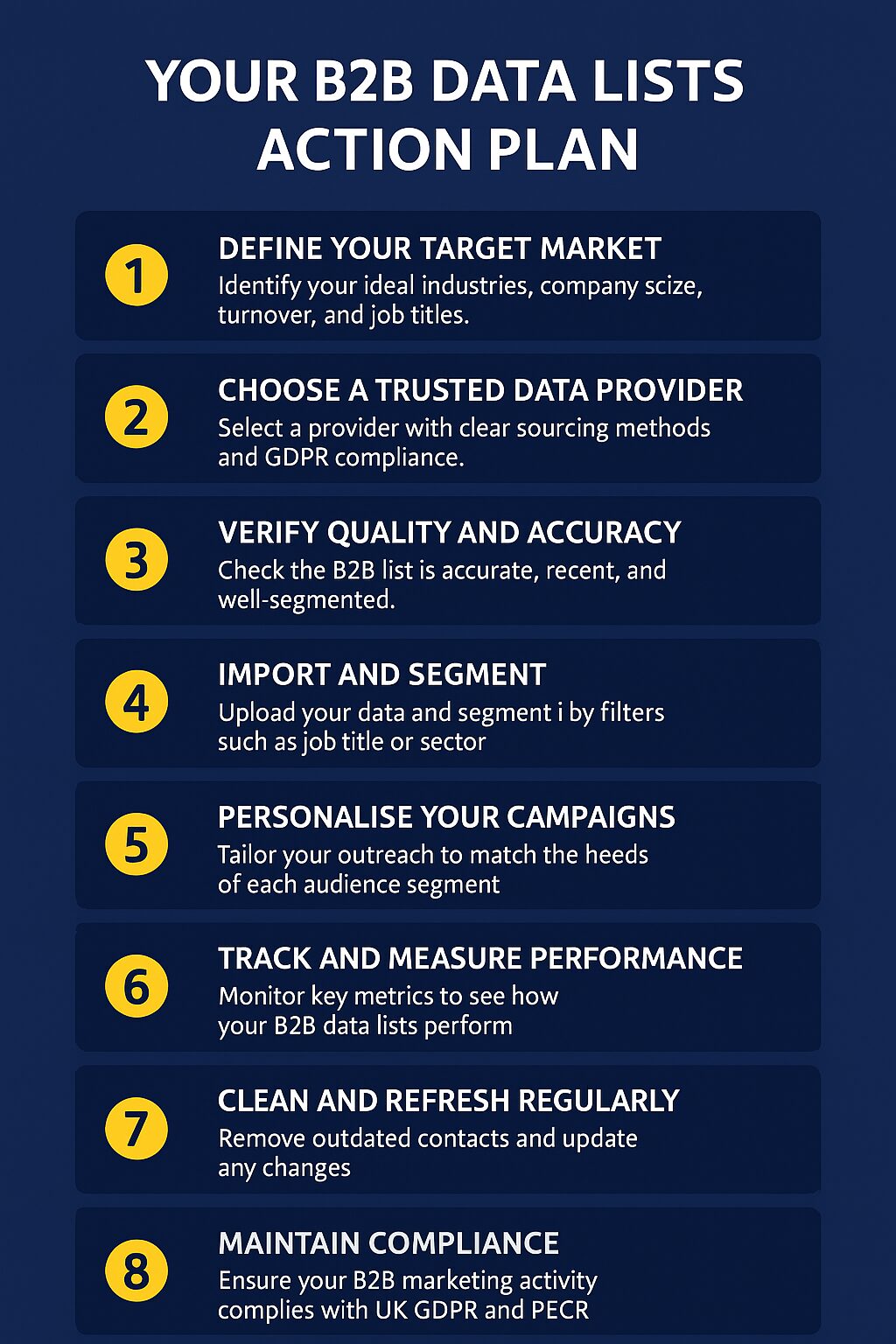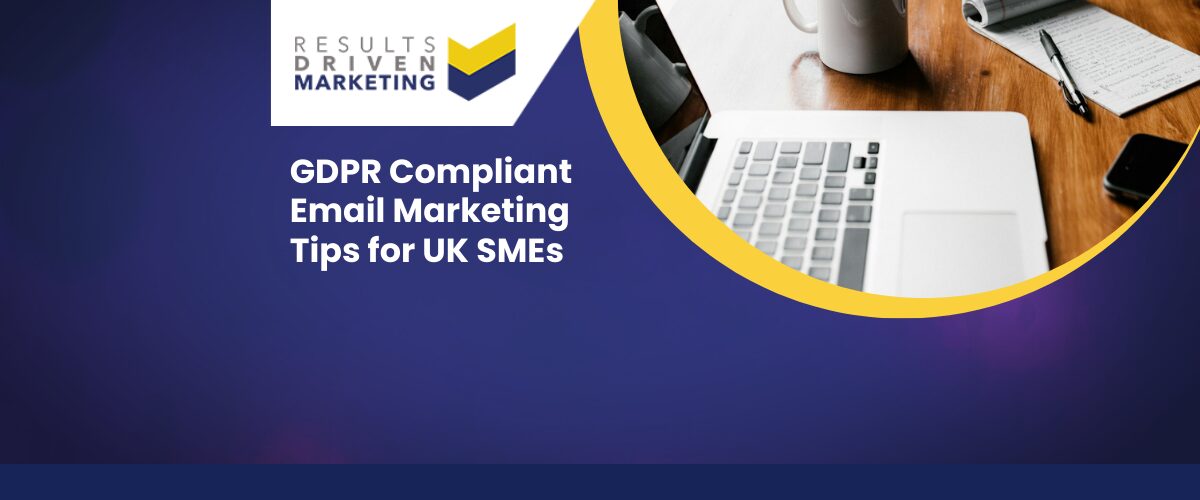
B2B Data Lists: How to Buy, Use and Maintain Them
B2B data lists are the foundation of every effective marketing strategy. They give you the power to identify, reach, and engage the right businesses with precision. Whether your goal is to build awareness, generate leads, or close more sales, success depends on the quality of the data that supports your campaigns.
For many UK companies, using well-structured B2B data lists transforms marketing from guesswork into a predictable, measurable system. When your data is accurate, segmented, and compliant, your team can focus on conversations that matter instead of wasting time on poor or irrelevant contacts.
Yet too many businesses still treat data as an afterthought. They buy lists without understanding how they were sourced, how often they are updated, or how to maintain them once they’re in use. The result is missed opportunities, wasted spend, and campaigns that underperform.
This guide will show you a better way. You’ll learn what makes a great B2B data list, how to evaluate providers, how to integrate new data into your marketing workflow, and how to maintain list accuracy over time.
At Results Driven Marketing, we’ve seen first-hand how powerful accurate data can be. When managed correctly, it becomes a long-term asset that drives visibility, sales, and profit. This article combines practical insight and proven strategies to help you buy, use, and maintain B2B data lists that consistently deliver results.
By the end of this guide, you’ll know how to approach data strategically, avoid common pitfalls, and build a system that supports ongoing business growth.
Table of contents:
What Are B2B Data Lists?
A B2B data list is a structured collection of information about businesses and their key decision-makers. These lists typically include company names, industry classifications, locations, and contact details such as names, job titles, phone numbers, and email addresses. In short, they provide the information you need to connect directly with the people who can buy your product or service.
What’s Inside a B2B Data List
Most professional B2B data lists contain several core fields:
-
Company Information: Business name, address, website, size, and turnover.
-
Contact Information: Decision-maker names, job titles, and verified contact details.
-
Industry Classification: Often based on SIC or NAICS codes, helping you target specific markets.
-
Location Data: Regional, national, or international targeting options.
-
Additional Insights: Optional fields such as technology used, company age, or growth stage.
The more complete and accurate these fields are, the more effective your outreach becomes. Well-structured data allows you to segment your audience, personalise messages, and match offers to the exact needs of each market segment.
Different Types of B2B Data Lists
Not all data lists are the same. Understanding the key categories helps you choose what suits your campaign best:
-
In-house lists: Built internally from your own customer data, enquiries, or event sign-ups. These lists are usually the most accurate because they’re based on direct engagement.
-
Purchased lists: Supplied by third-party providers who collect and compile business data. The quality depends on the source, update frequency, and how the provider validates their information.
-
Opt-in lists: Contain contacts who have explicitly agreed to receive marketing communication, often used for email campaigns requiring consent.
-
Enriched lists: Existing data that has been expanded or updated with additional information such as new contacts or firmographic details.
How B2B Lists Differ from Consumer Lists
Unlike consumer databases, which focus on individuals and lifestyle data, B2B data lists revolve around company structure, roles, and purchasing authority. Every record is designed to help you reach a specific professional within a business context.
For example, instead of targeting “people interested in IT,” a B2B list might identify “IT Managers at UK companies with over 50 employees.” This difference in targeting ensures your message lands with someone who has the budget, authority, or influence to take action.
Why This Matters
When you use a carefully built B2B data list, you’re not just buying names and numbers — you’re gaining access to real opportunities. The accuracy, segmentation, and structure of your data determine how efficiently your sales and marketing teams can perform.
High-quality lists empower your business to communicate with relevance, build trust, and increase response rates. Poor-quality lists, on the other hand, can damage your reputation and waste resources.
Why B2B Data Lists Are Essential for Growth
A well-built B2B data list is one of the most powerful tools in modern marketing. It’s not just a database of names and numbers; it’s the foundation that supports every stage of your lead generation, sales, and customer acquisition process. When your data is accurate, relevant, and compliant, it becomes the engine that drives consistent business growth.
1. Precision Targeting
High-quality B2B data lists allow you to reach decision-makers who actually fit your target customer profile. Instead of wasting time contacting businesses outside your market, your team can focus entirely on prospects that match your ideal buyer criteria. Whether that means targeting UK-based SMEs, specific industries, or companies with certain employee counts or turnover ranges, precision targeting ensures your campaigns deliver maximum return.
2. Increased Efficiency and Productivity
Every hour spent chasing the wrong lead costs money. A clean, well-segmented data list helps sales and marketing teams work smarter. With accurate information, you can personalise outreach, automate follow-ups, and move prospects through your funnel faster. This efficiency often leads to higher conversion rates and lower customer acquisition costs.
3. Stronger Campaign ROI
When your targeting is precise, your message is more relevant. That relevance drives higher open rates, better click-through rates, and stronger response rates across all channels — from email and social outreach to telemarketing and direct mail. Ultimately, your marketing spend goes further, and you see measurable improvements in ROI.
4. Compliance and Reputation Protection
Poor-quality or non-compliant data can create serious legal and reputational problems. Using B2B data lists that are GDPR and PECR compliant gives you peace of mind that your campaigns meet UK data regulations. It also reinforces credibility with your audience by showing your brand respects privacy and operates ethically.
5. Better Personalisation and Customer Experience
Modern buyers expect relevance. The more detailed and accurate your B2B data list, the easier it becomes to tailor your content, offers, and timing to specific audiences. Personalisation turns cold outreach into meaningful communication — and helps build stronger, long-term relationships with potential clients.
6. Data-Driven Decision Making
Your data doesn’t just support outreach — it fuels insight. Analysing engagement patterns, conversion rates, and response metrics across different audience segments helps you understand what works and what doesn’t. That intelligence allows you to continuously refine your campaigns and allocate budgets more effectively.
7. Competitive Advantage
Companies that invest in accurate data lists stay ahead of those that don’t. While competitors are wasting time cleaning poor data or requalifying leads, you can focus on closing deals and building relationships. Reliable B2B data gives your team the confidence to act quickly and strategically in competitive markets.
How to Evaluate and Buy High-Quality B2B Data Lists
When it comes to growing your business through targeted marketing, few investments are more important than the quality of your B2B data list. The right list connects you with genuine decision-makers, boosts conversion rates, and helps your marketing budget work harder. The wrong one wastes time, money, and reputation. Buying data should never be rushed; it requires understanding, research, and careful supplier selection.
1. Define Your Objectives Clearly
Before you contact any B2B data list provider, get crystal clear on what you need. Identify your ideal customer profile, preferred industries, company size, turnover range, and whether you need regional or nationwide coverage. If you’re operating in the UK, make sure your list focuses on business data lists UK that fit your exact campaign goals.
Clear targeting allows you to brief suppliers accurately and ensures your investment delivers real results.
2. Prioritise Accuracy and Recency
A list is only as good as its data. Outdated records, invalid emails, or incorrect phone numbers can derail a campaign before it begins. The best business data lists UK B2B marketing teams rely on are those updated regularly, verified against multiple sources, and maintained through continuous cleansing.
Ask every provider how often they refresh their databases and how they verify new entries. If they can’t give a clear answer, they’re not worth your trust.
3. Choose a Transparent Supplier
A reliable B2B data provider should have no problem explaining where their data comes from and how it’s verified. The strongest B2B data providers list their sources openly and can demonstrate compliance with GDPR and PECR regulations. Look for companies that gather business data from public records, company filings, and validated industry sources. Avoid any supplier that can’t show transparency or proof of consent.
4. Check for Compliance and Legal Integrity
When buying B2B data lists UK, compliance is non-negotiable. Under UK GDPR and PECR, you’re responsible for ensuring that any data you use for marketing is lawful and fairly processed. Choose a supplier registered with the ICO, confirm their data collection practices, and keep a copy of your purchase agreement for audit purposes.
Working with compliant data not only protects your business but also builds trust with your audience.
5. Look for Advanced Segmentation Options
The best business data lists UK B2B marketing professionals use aren’t generic spreadsheets — they’re intelligently segmented by industry, company size, region, and job title. Granular segmentation lets you personalise your campaigns, reach the right audience, and increase your response rates.
Ask your provider about available filters and ensure you can target specific roles such as “Marketing Director” or “Operations Manager” within your desired sectors.
6. Request a Data Sample
Before committing to a full list, request a small sample. Review it carefully for accuracy, formatting, and relevance. Any reputable B2B data list provider will happily share a preview of their work. This quick step can save you from purchasing data that doesn’t match your campaign requirements.
7. Evaluate Pricing and Value
Cheap data is rarely good value. High-quality B2B data lists require consistent updates, validation, and segmentation — all of which come at a cost. The goal isn’t to find the cheapest list but to ensure every pound spent contributes to measurable campaign performance.
Transparent pricing and clear record counts are signs of a credible provider.
8. Build Long-Term Partnerships
Treat your data supplier as a strategic partner, not a one-off vendor. The most effective relationships come from continuous collaboration — reviewing campaign performance, refining target sectors, and sourcing fresh data as markets evolve.
A trusted B2B data provider will help you maintain data quality, suggest new segmentation strategies, and keep your marketing ahead of the competition.
9. Track Results and Refresh Regularly
Once your campaign is live, track key metrics such as deliverability, bounce rates, engagement, and conversions. Analysing these figures shows you how your list performs and when it’s time for a refresh. Keep detailed notes on which B2B data lists UK performed best and why.
Over time, this insight helps you build a custom B2B data list strategy that supports sustainable growth and consistent ROI.
Selecting the Right Data Provider and Vendor Checklist
Choosing the right B2B data list provider is one of the most important decisions you’ll make in your marketing strategy. The market is crowded with suppliers promising accuracy and compliance, but not all of them deliver. To get the best results from your business data lists UK, you need a supplier who combines transparency, data integrity, and strategic support.
1. Look for Proven Experience
The best B2B data providers list includes companies with years of experience supplying accurate, compliant, and regularly updated records. A credible provider understands the UK market, keeps databases current, and provides tailored solutions for different sectors.
Ask how long the supplier has been operating, what industries they specialise in, and whether they have existing clients in your field. Longevity and reputation are strong indicators of trustworthiness.
2. Verify Data Sourcing and Collection
A transparent B2B data provider will always explain where their data comes from and how it’s validated. The best B2B data lists UK are built from reputable public records, Companies House filings, and verified industry sources.
Be cautious of suppliers that cannot or will not share their sourcing process. Hidden methods often mean poor-quality or non-compliant data, which could put your campaigns — and your reputation — at risk.
3. Demand Regular Data Updates
Data decays fast. Job titles change, businesses relocate, and companies close. The most reliable B2B data lists are refreshed every 3–6 months, removing duplicates, inactive contacts, and invalid emails. Always ask your provider how frequently they update and cleanse their records.
A strong update cycle is what separates the best business data lists UK B2B marketing teams rely on from the rest.
4. Assess Data Coverage and Segmentation
Your provider should offer broad yet targeted coverage across UK industries. Look for options to segment by job title, turnover, region, company size, or sector. High-level segmentation makes your outreach more relevant and cost-effective, whether you’re targeting SMEs, corporates, or niche industries.
When reviewing potential vendors, ensure their B2B data lists UK include the depth and flexibility your campaigns need.
5. Test Customer Service and Responsiveness
Good data is valuable, but so is good service. The best B2B data providers don’t just sell lists — they help you make the most of them. Look for suppliers who offer support, advice, and quick turnaround times.
At Results Driven Marketing, for instance, our clients receive counts within hours and data dispatch within 24 hours, allowing them to get campaigns live without delay. That level of responsiveness should be your benchmark.
6. Review Compliance Credentials
Compliance is critical when purchasing business data lists UK. Your provider should be fully GDPR and PECR compliant and registered with the ICO. Request documentation or a compliance statement before purchasing.
Working with a transparent and accountable vendor ensures your marketing stays ethical, legal, and effective.
7. Compare Value, Not Just Price
It’s tempting to choose the cheapest option, but data is one area where you get what you pay for. The best business data lists UK B2B marketing professionals use are those that deliver measurable ROI — not those that simply cost less upfront.
Evaluate value based on data accuracy, segmentation depth, update frequency, and service quality. Reliable data pays for itself many times over.
8. Build a Long-Term Partnership
Your relationship with your data supplier shouldn’t end after one purchase. As your business evolves, your targeting needs will too. A strong partnership means your provider can recommend new audiences, refine your segmentation, and provide updated data when you need it.
A consistent supplier relationship also saves you from the hassle of re-evaluating vendors every time you launch a new campaign.
How to Integrate Your B2B Data List Into Marketing and Sales Workflows
Once you’ve purchased your B2B data list, the real value begins when you integrate it properly into your marketing and sales workflows. The best business data lists UK B2B marketing teams use aren’t just stored in spreadsheets — they’re actively managed, segmented, and synchronised across systems to drive measurable results.
1. Import and Clean Your Data
Before using your new list, start with a thorough clean. Even the best business data lists UK can contain small errors or duplicates. Run a quick check for formatting issues, remove redundant entries, and validate email addresses where possible.
Upload your data into your CRM or marketing platform, and ensure all fields (such as company name, contact title, and email address) align with your existing database structure. This keeps everything consistent and avoids confusion when launching campaigns.
2. Segment for Relevance
Segmentation is what transforms a B2B data list into a strategic marketing asset. Group contacts by criteria such as industry, job role, company size, or region. Tailored messaging is far more effective than one-size-fits-all campaigns.
For example:
-
Target Marketing Directors in the South East with campaign strategy emails.
-
Send product demos to IT Managers in medium-sized businesses.
-
Offer service trials to Operations Managers in the manufacturing sector.
Well-segmented lists help your B2B marketing efforts feel personal, timely, and relevant.
3. Sync Data With Your CRM and Automation Tools
Integrating your B2B data lists UK into your CRM or email automation software ensures your team can manage contacts seamlessly. Platforms like HubSpot, Mailchimp, or Salesforce allow you to assign tags, track engagement, and nurture leads over time.
A high-quality B2B data provider should be able to deliver data in CRM-ready formats such as CSV or Excel, making import simple. Once your data is live, you can set up automated workflows — welcome sequences, follow-ups, or re-engagement campaigns — to keep your outreach consistent.
4. Personalise Your Campaign Messaging
The best business data lists UK B2B marketing teams rely on allow for deep personalisation. Use the data you’ve imported — such as job title, company size, or sector — to craft relevant, engaging messages.
Personalisation goes beyond using someone’s name. It’s about showing that you understand their industry and challenges. For instance, an email that references “IT infrastructure management” resonates more with a CIO than a generic “business solutions” pitch.
5. Use Multi-Channel Campaigns
Modern buyers interact across multiple platforms. Integrate your B2B data list into multi-channel outreach that includes:
-
Email marketing for consistent communication.
-
Telemarketing for direct conversations.
-
LinkedIn outreach for relationship building.
-
Direct mail for high-impact campaigns targeting senior decision-makers.
Combining channels improves visibility and response rates, helping your B2B data lists UK perform at their full potential.
6. Track and Measure Performance
Data integration is only valuable if it leads to measurable results. Monitor your campaign metrics — delivery rates, open rates, click-throughs, and conversions — to assess performance across each audience segment.
Use these insights to refine future campaigns, eliminate underperforming segments, and continually improve your targeting. The most effective B2B data providers use feedback loops like these to enhance future selections and improve list accuracy.
7. Keep Data Flowing and Updated
A successful integration is not a one-time process. As campaigns progress, keep your data clean and synchronised. Update contact details, remove unsubscribes, and feed new information back into your master database.
Working with a reliable B2B data list provider who offers regular updates ensures your lists stay accurate and compliant over time. Consistency is key to building long-term marketing momentum.
Maintaining and Refreshing Your B2B Data Lists
Buying a high-quality B2B data list is only the beginning. The real challenge lies in maintaining its accuracy, relevance, and performance over time. Even the best business data lists UK B2B marketing teams use can lose value quickly if not managed properly. On average, business data decays by 30–40% each year as people change roles, companies move, or new firms emerge.
A clean, regularly refreshed list protects your campaign performance and ensures every pound you spend on marketing continues to deliver a measurable return.
1. Understand Why Data Decays
Data naturally becomes outdated for several reasons:
-
Employees change jobs or companies.
-
Businesses relocate, merge, or close.
-
Contact details such as phone numbers or email addresses are updated.
-
Company information like turnover or staff count changes.
Without regular maintenance, your B2B data lists UK will slowly fill with inactive or irrelevant contacts, leading to wasted effort and higher bounce rates.
2. Schedule Regular Cleansing
A structured data cleansing process is essential for keeping your lists performing. Review and refresh your business data lists UK every 3–6 months. Remove undeliverable emails, incorrect information, and duplicates.
At Results Driven Marketing, we recommend building a data refresh schedule that aligns with your campaign cycles. This ensures your B2B marketing activity always relies on accurate, compliant information.
3. Use Data Enrichment Services
Sometimes it’s not about removing data but improving it. B2B data providers often offer enrichment services that add new information to existing records. This could include new contacts at the same company, updated job titles, or additional firmographic details such as turnover or location.
Enrichment helps your B2B data list stay current and enhances segmentation options, allowing your campaigns to remain relevant and precise.
4. Monitor Deliverability and Engagement
One of the easiest ways to identify poor-quality or outdated data is through campaign performance. Keep an eye on:
-
Bounce rates – High bounce rates often indicate outdated contacts.
-
Open rates – Low engagement may suggest poor targeting.
-
Unsubscribes – Can highlight irrelevant or overused data segments.
By monitoring performance regularly, you can quickly spot when it’s time to cleanse or refresh your B2B data lists UK and maintain list health.
5. Re-verify Key Contacts
If you rely heavily on specific accounts or decision-makers, periodically re-verify their contact information. A quick check can save you from sending emails or calling outdated numbers. Many B2B data providers list re-verification services as part of their maintenance support, ensuring data stays compliant and usable.
6. Keep Your CRM in Sync
Once data is cleansed or enriched, sync it back into your CRM or automation platform to keep systems consistent. Disconnected databases lead to inefficiency, duplicate contacts, and reporting errors. A unified, up-to-date data environment strengthens every aspect of your B2B marketing activity.
7. Partner With a Reliable Data Provider
A strong relationship with your B2B data list provider makes ongoing maintenance easier. Trusted suppliers not only deliver fresh lists but also monitor trends, identify inactive records, and proactively recommend updates.
When you choose the best business data lists UK B2B marketing companies rely on, you’re effectively partnering with a data specialist who helps your business stay ahead of market shifts.
8. Maintain GDPR and PECR Compliance
Refreshing your data is also a chance to review compliance. Ensure your contact information aligns with current UK GDPR and PECR regulations. Remove any contacts that no longer meet compliance standards and document your data processing activities.
Staying compliant protects your brand reputation and ensures your marketing remains legally sound.
Advanced Filters, Use Cases and Niche Segments
Once you’ve mastered the basics of buying and maintaining B2B data lists, the next step is learning how to use advanced filters to unlock greater targeting precision. The most successful B2B marketing campaigns are built on well-segmented, insight-driven data that allows for smarter outreach and stronger engagement.
1. Go Beyond Basic Demographics
Traditional business data lists UK often focus on standard firmographic details such as industry, company size, and location. While these are important, they’re only the beginning. Advanced segmentation gives your campaigns the power to reach prospects based on real-world behaviour, intent, and technology use.
Some of the most effective filters include:
-
Technographics: Identify which software, platforms, or systems a company uses.
-
Intent Data: Target businesses showing active interest in your products or services online.
-
Job Seniority and Function: Reach decision-makers, not just employees.
-
Revenue Band or Growth Rate: Focus on businesses in expansion mode for higher conversion potential.
By applying these filters, you turn a generic B2B data list into a precision marketing tool.
2. Build Campaigns Around Specific Use Cases
Your data can be used in many ways depending on your campaign goals. For example:
-
Lead Generation Campaigns: Reach new prospects who match your buyer persona.
-
Event Promotion: Invite decision-makers from relevant industries to webinars or conferences.
-
Product Launches: Target companies that use complementary technologies or services.
-
Market Research: Analyse patterns across specific industries or geographic regions to identify growth opportunities.
When you work with a trusted B2B data list provider, they can tailor the data to fit each use case. This ensures that your outreach always feels timely, relevant, and valuable.
3. Create Niche Segments for Higher ROI
The real power of B2B data lists UK lies in their flexibility. Instead of buying broad lists that cover thousands of companies, focus on narrow, well-defined niches. A smaller but highly relevant dataset often performs far better than a large, unfocused one.
For example:
-
A software vendor might target manufacturing companies using legacy ERP systems.
-
A marketing agency could focus on UK accountancy firms with 10–50 employees.
-
A logistics company might reach out to eCommerce brands with high shipping volumes.
These tailored audiences deliver higher open rates, stronger response rates, and improved ROI.
4. Align Data With Buyer Intent
Combining B2B data lists with intent signals helps you reach prospects who are actively looking for solutions like yours. Intent-based targeting allows your B2B marketing campaigns to prioritise leads already in the research or decision stage.
When you purchase from the best business data lists UK B2B marketing providers, you can often request this type of enhanced data to increase campaign efficiency.
5. Leverage Data Across Multiple Channels
Advanced segmentation makes it easier to launch coordinated campaigns across email, LinkedIn, and phone outreach. Consistency across channels reinforces your message and increases brand recognition.
For example:
-
Use email to introduce your offer.
-
Follow up with LinkedIn outreach to build credibility.
-
Schedule telemarketing calls with interested contacts to move deals forward.
Integrated campaigns built around segmented B2B data lists UK help you reach audiences from multiple angles and build familiarity faster.
6. Collaborate With Your Data Provider for Custom Insights
The most effective results come from collaboration. Leading B2B data providers don’t just hand over a list — they help analyse your previous campaigns, recommend new filters, and identify untapped markets.
At Results Driven Marketing, we regularly help clients refine their targeting using historical performance data and emerging market trends. Working closely with your B2B data list provider gives you a competitive edge that generic data sources simply can’t match.
Common Pitfalls and How to Avoid Them
Even the most experienced marketers can run into problems when buying or using B2B data lists. From compliance issues to poor targeting, the consequences of bad data can be costly — both financially and reputationally. Understanding these pitfalls helps you make smarter decisions and build campaigns that actually perform.
Below are the most common mistakes businesses make when dealing with B2B data lists UK, along with practical advice on how to avoid them.
1. Buying Data Based on Price, Not Quality
The temptation to buy cheap business data lists UK can be strong, especially when you’re managing tight marketing budgets. But low-cost lists often contain outdated, incomplete, or non-compliant records. The short-term savings quickly disappear once you face high bounce rates, wasted campaign spend, or even legal risk.
Avoid it: Always work with a reputable B2B data list provider that clearly explains how their data is sourced, updated, and verified. Ask for a sample before purchasing and check the data’s relevance and accuracy.
2. Ignoring GDPR and PECR Compliance
Data compliance is not optional. If your campaigns involve emailing, calling, or mailing businesses in the UK, you must ensure your B2B data lists are fully compliant with GDPR and PECR regulations. Non-compliance can result in fines and long-term damage to your company’s reputation.
Avoid it: Choose only trusted B2B data providers who are registered with the ICO and can prove that their data has been collected lawfully. At Results Driven Marketing, all our lists are GDPR and PECR compliant, giving our clients complete confidence to run campaigns safely and ethically.
3. Using Unsegmented or Poorly Targeted Lists
A common mistake is using broad, unfiltered data that targets “everyone and anyone.” The result is wasted effort, low engagement, and poor conversion rates. The best B2B marketing campaigns focus on specific audiences that match your ideal buyer profile.
Avoid it: Use segmentation tools and filters to target by job title, company size, industry, or location. Your B2B data list should always be aligned with your campaign goal.
4. Failing to Clean and Refresh Data Regularly
Even the best business data lists UK B2B marketing professionals buy won’t stay perfect forever. Without ongoing cleansing, data quickly becomes outdated. Every email bounce or wrong phone number represents lost opportunities.
Avoid it: Schedule regular cleansing and enrichment. Remove duplicates, invalid contacts, and bounced emails. Keep your CRM synchronised and always use the most recent version of your list.
5. Buying Data Without Testing First
Many businesses skip the sampling stage, assuming the data will meet expectations. When it doesn’t, campaign performance suffers and the investment is wasted.
Avoid it: Always request a test sample from any B2B data list provider. Send a small campaign to measure deliverability and engagement before scaling up.
6. Neglecting Integration With CRM and Automation Tools
Even high-quality B2B data lists lose value if they’re not properly integrated with your marketing and sales systems. Manual uploads and inconsistent data fields can cause errors and confusion.
Avoid it: Import your data into your CRM or email marketing platform using consistent formatting. Tag contacts, segment audiences, and automate workflows to make your outreach seamless and efficient.
7. Focusing on Quantity Over Relevance
Bigger isn’t always better. Many businesses assume that the larger their list, the better their campaign results will be — but this often leads to poor engagement. A smaller, more focused list nearly always performs better.
Avoid it: Prioritise data quality and audience relevance. Work with a B2B data provider who helps you refine your selection based on campaign objectives.
8. Not Measuring or Learning From Results
If you don’t track outcomes, you’ll never know which lists or strategies deliver the best ROI. Many companies keep buying the same kind of data without evaluating performance.
Avoid it: Analyse every campaign. Track open rates, click-throughs, conversions, and cost-per-lead. Use these insights to improve your future data selections and refine your targeting.
Checklist: Your B2B Data Lists Action Plan
After exploring how to buy, use, and maintain B2B data lists, it helps to bring everything together into a clear, repeatable process. This action plan gives you a step-by-step framework you can use before, during, and after every data purchase. Whether you’re sourcing new business data lists UK or refreshing your existing records, following these steps keeps your marketing compliant, cost-effective, and results-driven.
Step 1: Define Your Target Market
Start by identifying exactly who you want to reach. Consider industry, company size, turnover, and job title. The more specific you are, the easier it becomes to find the right contacts and avoid irrelevant data. This is the foundation of every successful B2B marketing campaign.
Step 2: Choose a Trusted Data Provider
Select a B2B data list provider with clear sourcing methods, GDPR and PECR compliance, and a proven track record in the UK market. Ask for a sample and check that data fields match your campaign needs.
Step 3: Verify Quality and Accuracy
Ensure your chosen list is accurate, recent, and well-segmented. The best business data lists UK B2B marketing professionals use are updated regularly and validated from multiple sources.
Step 4: Import and Segment
Upload your data into your CRM or marketing platform, ensuring consistent formatting. Then, segment your contacts by filters such as job title, region, or sector. Segmentation enables targeted messaging that resonates with each audience group.
Step 5: Personalise Your Campaigns
Tailor your outreach to match the needs and language of each segment. Personalised messages drive higher open and response rates and make your brand feel authentic and credible.
Step 6: Track and Measure Performance
Monitor delivery, engagement, and conversion metrics to understand how your B2B data lists UK perform. Analysing results helps you refine future campaigns and identify your highest-converting audiences.
Step 7: Clean and Refresh Regularly
Schedule ongoing data cleansing and enrichment. Remove invalid or inactive contacts and update any changed details. Fresh, accurate data keeps your campaigns compliant and effective.
Step 8: Maintain Compliance
Document your data sources, consent status, and usage processes. Always ensure your B2B marketing activity aligns with GDPR and PECR regulations to protect your reputation and customer trust.
Step 9: Partner for Long-Term Success
Build a long-term relationship with your supplier. Reliable B2B data providers will support your growth, provide updated selections, and help you adapt your targeting as markets evolve.
Step 10: Review, Learn, and Optimise
After each campaign, review what worked best — segment performance, response rates, ROI — and feed those insights into your next strategy. Data-driven refinement is the key to consistent improvement.
Conclusion and Next Steps
Building and managing effective B2B data lists is more than a simple administrative task — it’s one of the most powerful ways to drive measurable growth in your business. When you combine accuracy, compliance, and strategy, data transforms from a static spreadsheet into a living, revenue-generating asset.
By following the best practices outlined in this guide — from evaluating suppliers and verifying compliance, to segmenting, integrating, and refreshing your data — your marketing and sales teams can focus on what matters most: connecting with real decision-makers and closing deals.
The UK market is highly competitive, and access to business data lists UK that are accurate, up-to-date, and GDPR-compliant gives you a significant advantage. Whether you’re running email campaigns, telemarketing, or multi-channel outreach, the quality of your data determines your success.
Partnering with a trusted B2B data list provider ensures that your campaigns are built on solid foundations. The best business data lists UK B2B marketing teams rely on come from transparent, reputable providers who invest in data accuracy, segmentation, and regular updates.
At Results Driven Marketing, we help businesses of all sizes access premium B2B data lists UK that are tailored to their target audience and campaign goals. Every record we supply is sourced responsibly, cleaned regularly, and structured for performance. Our team works alongside you to identify the right sectors, job roles, and company profiles so your outreach consistently delivers results.
Your Next Step
If you’re ready to improve your targeting, increase your response rates, and turn your data into a long-term business asset, it’s time to take the next step.
-
Audit your current data — identify outdated, inaccurate, or underperforming records.
-
Define your ideal customer profile — industry, company size, and decision-maker type.
-
Speak to a data expert — find a provider that understands your goals and can recommend the right approach.
When you’re ready to elevate your B2B marketing performance, we’re here to help. At Results Driven Marketing, we’ll work with you to build, refine, and maintain a powerful B2B data list that fuels your growth for years to come.


